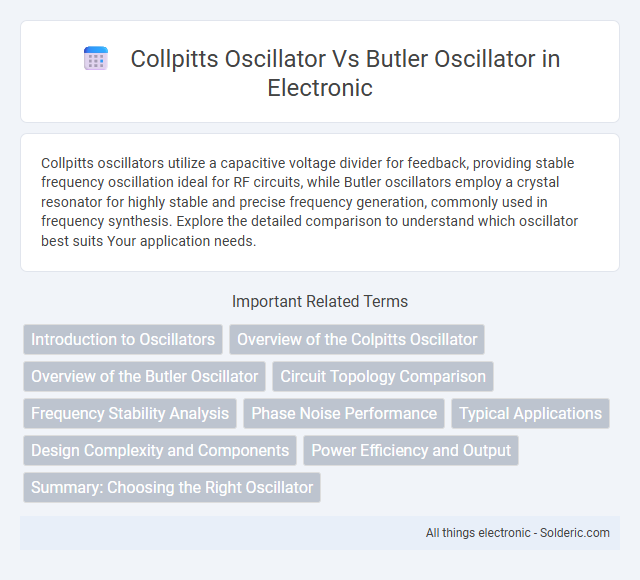Collpitts oscillators utilize a capacitive voltage divider for feedback, providing stable frequency oscillation ideal for RF circuits, while Butler oscillators employ a crystal resonator for highly stable and precise frequency generation, commonly used in frequency synthesis. Explore the detailed comparison to understand which oscillator best suits Your application needs.
Comparison Table
| Feature | Colpitts Oscillator | Butler Oscillator |
|---|---|---|
| Oscillation Principle | Uses capacitive voltage divider in LC tank circuit | Uses quartz crystal for frequency stabilization |
| Frequency Stability | Moderate, depends on LC components | High, due to quartz crystal resonance |
| Typical Frequency Range | Low MHz to tens of MHz | High MHz, often for precise clock generation |
| Application | General-purpose oscillators in RF circuits | Crystal-controlled clock oscillators in communication systems |
| Output Waveform | Sine wave with some harmonic distortion | Highly stable sine wave |
| Complexity | Simple LC network | More complex due to crystal and additional components |
| Phase Shift | Provided by capacitive divider | Provided by crystal and amplifier loop |
Introduction to Oscillators
Collpitts oscillators utilize a capacitive voltage divider for feedback, offering stable frequency generation primarily in RF applications. Butler oscillators employ a crystal resonator with a specialized amplifier configuration to achieve high frequency stability and low phase noise. Both oscillators serve as fundamental components in communication systems, where precise frequency control is crucial.
Overview of the Colpitts Oscillator
The Colpitts oscillator is a type of LC oscillator that uses a capacitive voltage divider as its feedback network, typically consisting of two capacitors and an inductor. This oscillator is renowned for its stable frequency generation and high-quality sinusoidal output, making it ideal for RF and communication applications. Compared to the Butler oscillator, which employs a quartz crystal for frequency control, the Colpitts oscillator offers easier frequency tuning but generally lower frequency stability.
Overview of the Butler Oscillator
The Butler oscillator is a type of crystal oscillator known for its high frequency stability, using a quartz crystal as the frequency-determining element within its feedback network. Unlike the Colpitts oscillator, which relies on a capacitive voltage divider for feedback, the Butler oscillator employs a crystal in a Pierce or similar configuration to achieve precise frequency control. Your choice between these oscillators depends on the required accuracy and stability in applications like communication systems or signal generators.
Circuit Topology Comparison
The Colpitts oscillator features a capacitive voltage divider formed by two capacitors in series, providing feedback through the junction between them, which sets its oscillation frequency in conjunction with the inductance. The Butler oscillator employs a crystal resonator in its feedback path, ensuring high frequency stability by leveraging the piezoelectric properties of the crystal, typically combined with a capacitive network and an active device like a transistor or an operational amplifier. While the Colpitts circuit relies on LC tank circuits for frequency determination, the Butler oscillator's topology centers around crystal control, making it superior for applications requiring precise and stable frequency references.
Frequency Stability Analysis
The Colpitts oscillator exhibits moderate frequency stability influenced by temperature variations and component tolerances within its LC tank circuit, making it suitable for general-purpose applications. The Butler oscillator, employing a quartz crystal resonator, offers superior frequency stability with minimal drift, achieving precision in frequency control ideal for high-stability and low-phase noise requirements. Crystal-controlled Butler oscillators outperform Colpitts circuits in maintaining consistent oscillation frequency over time and environmental changes due to the inherent stability of quartz resonators.
Phase Noise Performance
The Butler oscillator typically exhibits lower phase noise compared to the Colpitts oscillator due to its use of an active resonator or feedback network that stabilizes frequency variations more effectively. Your choice of oscillator for low phase noise applications often favors the Butler topology for its superior spectral purity and reduced jitter. In contrast, the Colpitts oscillator, while simpler and more widely used, generally suffers from higher phase noise due to its passive tank circuit design and sensitivity to component variations.
Typical Applications
Collpitts oscillators are commonly used in radio frequency (RF) signal generation, local oscillators for communication transmitters, and clock generation in microprocessors due to their stable frequency and ease of tuning. Butler oscillators are typically employed in crystal oscillator circuits for high-precision frequency references in communication systems, GPS receivers, and stable timekeeping devices. The Collpitts design excels in applications requiring variable frequency control, whereas the Butler oscillator is preferred for ultra-stable, low-phase noise frequency sources.
Design Complexity and Components
The Collpitts oscillator features a simpler design with fewer components, primarily using a capacitive voltage divider to determine oscillation frequency. In contrast, the Butler oscillator incorporates more complex circuitry, including quartz crystals and additional transistors or capacitors, leading to higher design complexity and improved frequency stability. The Collpitts design suits basic RF applications, while the Butler oscillator is preferred for precision frequency generation in crystal-controlled environments.
Power Efficiency and Output
The Colpitts oscillator typically offers higher power efficiency due to its simpler LC circuit design, which minimizes energy loss during oscillation, making it suitable for applications requiring stable and efficient signal generation. In contrast, the Butler oscillator, often used in crystal-controlled frequency sources, provides superior frequency stability and cleaner output signals but may consume more power due to additional circuitry involved. Your choice depends on whether power efficiency or output signal purity is the priority in your application.
Summary: Choosing the Right Oscillator
Collpitts and Butler oscillators serve distinct roles in frequency generation, with Collpitts oscillators favored for their simplicity and stable frequency output using capacitive voltage division. Butler oscillators excel in ultra-stable crystal oscillator applications, offering superior phase noise and frequency stability due to their quartz crystal arrangement. Your choice depends on application needs: for moderate stability and ease of design, Collpitts is ideal, while Butler suits high-precision timing and communication systems.
collpitts oscillator vs butler oscillator Infographic

 solderic.com
solderic.com